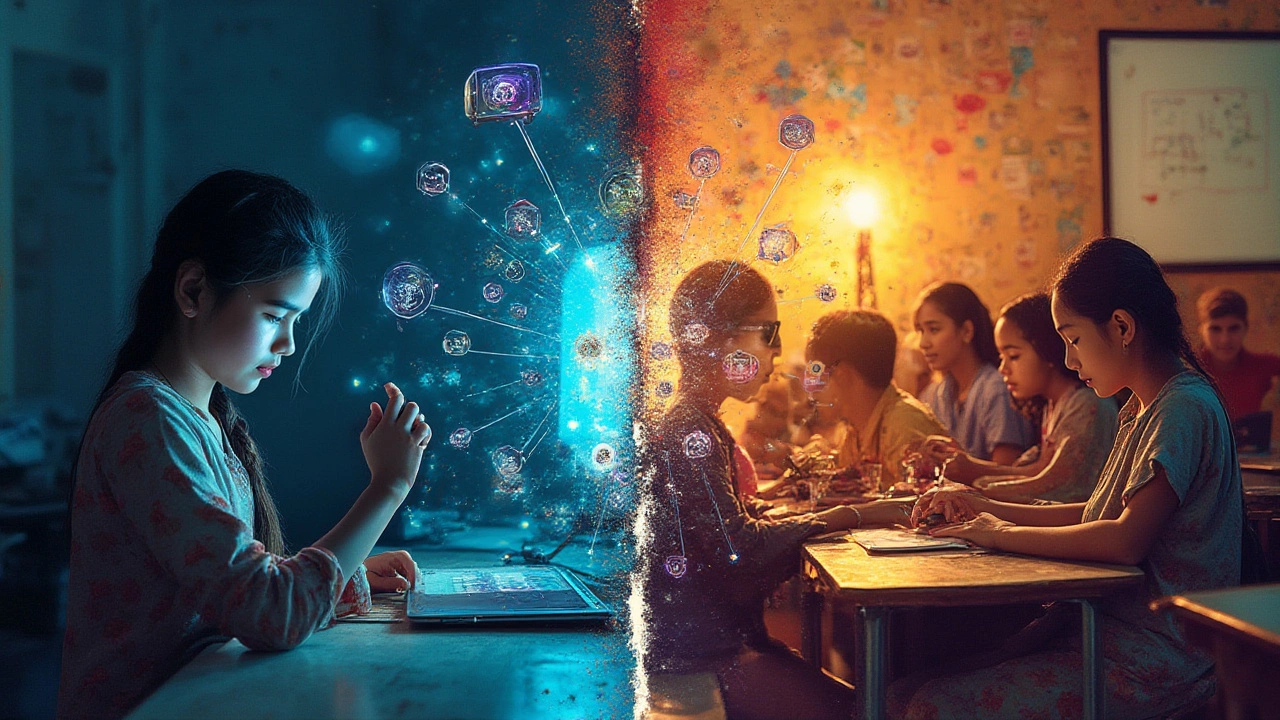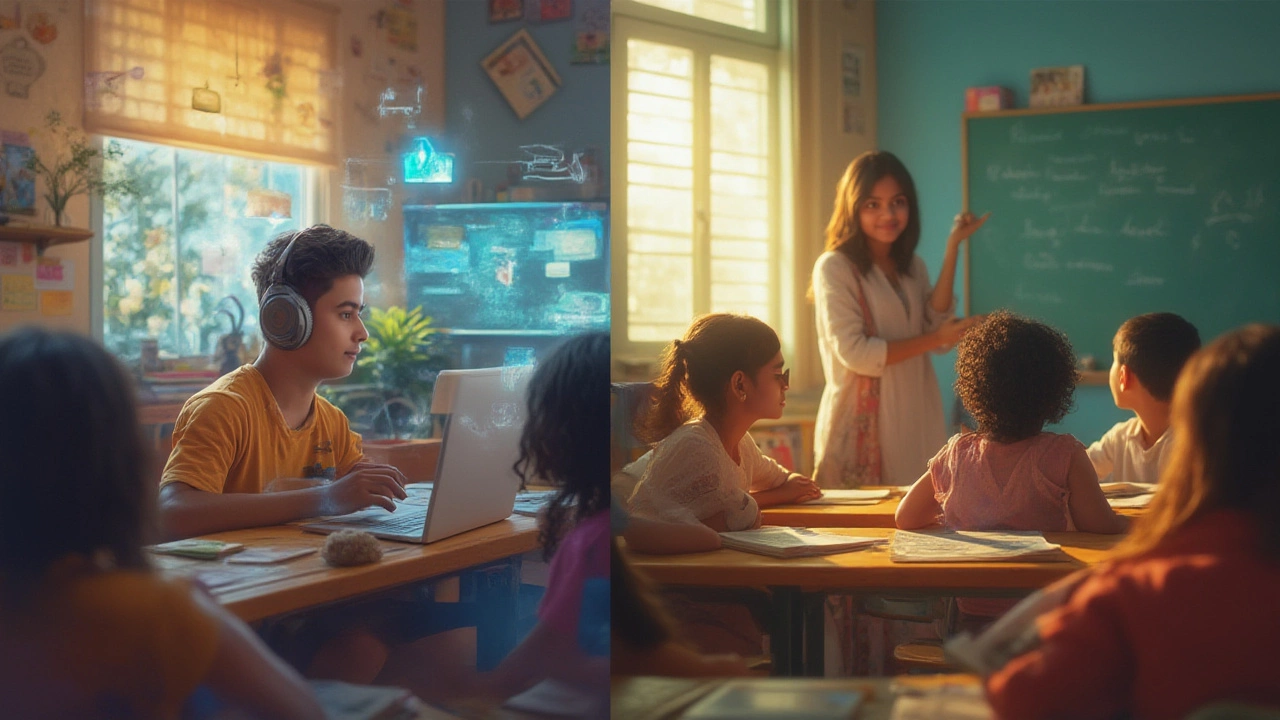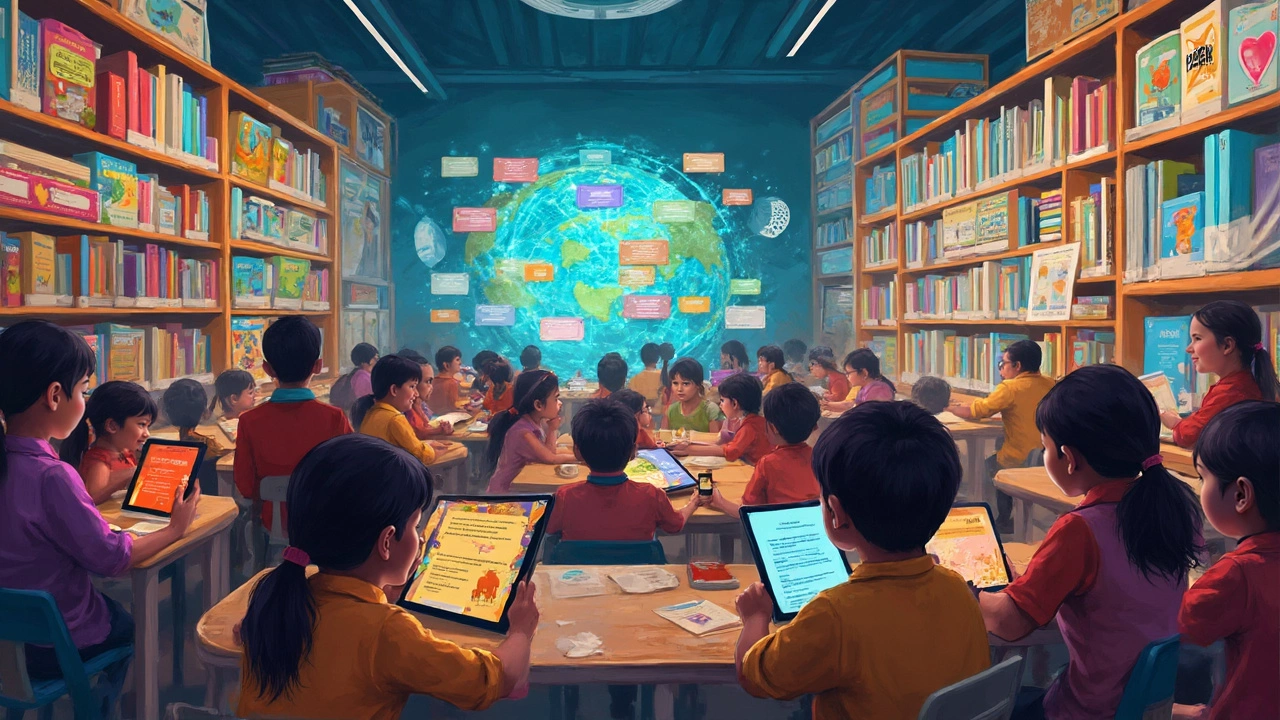800 million students worldwide suddenly found themselves studying from home during the pandemic. Flash forward to 2025, and buzzwords like "hybrid," "remote," and "in-person" still get thrown around at parent meetings and late-night study sessions. So, is learning through a screen actually better than crowding into a real classroom with fifty noisy classmates? This is a hot topic in every home, every school, and pretty much every family WhatsApp group. It’s not just about watching teachers talk from a laptop. It’s about what really helps learners grow – not just memorize facts for yet another test, but really understand, adapt, and thrive in this rapidly shifting world.
The Experience: How Distance and Classroom Learning Shape Students
Classroom learning has a routine. The bell rings. The teacher stands at the board. There’s that heavy smell of markers, a hint of chalk. You get instant feedback – Miss Thomas sees the confusion on your face and swoops in to clear things up. You swap jokes, trade pens, and scribble notes in the margins. That’s something virtual worlds struggle to copy. Sure, you can join a video call, but it’s tough to raise your hand on Zoom without someone talking over you. The environment matters: actual schools give structure, discipline, and space for students to find their own rhythm.
Distance learning feels different. On paper, you’re just a click away from the lesson. Platforms like Google Classroom and Moodle mean kids can rewind, pause, and review tricky points as many times as they like. There’s more freedom. You can build your day around your best learning hours, whether you’re a night owl or an early bird. For people who struggle with social anxiety, learning from the safety of your room makes participation less painful. And for those living far from good schools, the entire world is open: you can learn physics from MIT professors, code with Google engineers, or fine-tune your English with a tutor from London, all from your dining table.
But energy can dip fast when you’re staring at a screen alone. That group project feels awkward when you’re separated by three time zones and flaky internet. The magic of a spontaneous debate in a real class? Hard to replicate online. According to a survey by Pew Research Center in 2024, about 38% of students felt that online classes left them feeling disconnected. For younger kids, motivation drops quickly without face-to-face support. And let’s not forget: not every home has stable WiFi, a quiet space, or a working laptop. Digital deserts—areas without reliable internet—still exist, which can turn "distance learning" into "no learning."
So, do students actually learn better one way or the other? The University of Chicago’s 2023 study found high school students in blended programs (mix of online and in-person) performed 10% better in tests than those who stuck exclusively to either method. Having a mix keeps things fresh, but also shows that both approaches have real merit depending on the subject, age, and style of the learner.

Flexibility vs Structure: What Suits Different Learners?
Every student is different. Some thrive on being told exactly what to do at 8:00 am and having daily routines mapped out. Traditional classroom setups help with that. Students like these tend to perform better with clear, predictable time slots. Teachers can watch for signs of boredom, check homework on the spot, or spot when someone’s having trouble. Social learning happens naturally: group projects, lunchtime chats, and after-school clubs teach people how to navigate friendships, work in teams, and handle competition. Schools also teach life skills that go far beyond academics—think time management, dealing with setbacks, or just learning to show up on time every day.
Distance learning is a game-changer for folks who can’t fit into those rigid molds. Got a part-time job? Caring for younger siblings, or dealing with health issues? Distance learning lets you set your own schedule, sometimes finishing coursework faster than a regular semester. According to Coursera’s 2024 Global Skills Report, nearly 52% of undergraduates now sign up for at least one online course. Distance learning’s big gift is autonomy—setting goals, managing projects, and holding yourself accountable when there’s no teacher watching. These are skills that bosses pay big money for in the real world.
Still, self-discipline is a must. If you’re the type who starts off motivated but loses steam after a week, classrooms push you to keep going. Here are a few tips if you’re leaning toward distance learning:
- Designate a learning zone. Don’t try to learn in bed or with Netflix playing in the background.
- Set clear daily or weekly goals. Write them down where you can see them.
- Take real breaks—go outside, stretch, and hydrate. Don’t scroll endlessly.
- Keep asking questions. Email teachers, join forums, and participate in discussion boards.
- Fight the urge to multitask. Focus on one thing at a time.
Distance learning works best for organized learners who are comfortable with tech and can stay focused on their goals, while classroom learning offers more hands-on help and support for those who need it. But as schools improve their virtual and blended options, the line between the two is blurring more every year.

What Do the Numbers Say? Digging Into the Facts and Future Trends
Still wondering which path actually leads to better results? The answer isn’t simple, but some stats give clues. In the U.S., the National Center for Education Statistics found that high schoolers in well-structured e-learning programs were 8% more likely to pass their exams than those studying the same courses purely in-person—but only if they had tech support and regular check-ins. Meanwhile, a Cambridge University survey in India saw that students in crowded cities used online classes to avoid deadly commutes and air pollution, saving 10+ hours a week—then used the free time to study or work part-time.
Across Europe, 67% of employers now say they treat online and traditional degrees the same, especially if the skills are in demand (like coding, digital marketing, or graphic design). Some fields—like medicine, dentistry, or mechanics—really need hands-on, practical training, so classroom remains king. But tech subjects, business theory, and language learning? These actually benefit from online’s ability to bring in experts and peers from anywhere on the planet.
Take a look at this side-by-side data:
| Aspect | Distance Learning | Classroom Learning |
|---|---|---|
| Flexibility | High (customize pace & time) | Fixed schedule |
| Social Interaction | Low (forum chats, video calls) | High (physical presence) |
| Technical Needs | High (device & stable internet) | Low (pen, books, classroom) |
| Accessibility | Global (location independent) | Local (school-based) |
| Learning Outcomes* | Comparable or better if self-motivated | Consistent for most subjects |
*Based on recent blended learning studies, 2023-2025
It’s not just about students. Teachers now have more creative tools to give instant feedback—grading quizzes online, dropping comments on essays, sharing video tutorials, and directing group work through digital whiteboards. Parents can peek into their kids’ classes without setting foot in a school—good news for those juggling jobs but still keen to stay involved.
So, what about the future? Hybrid models are exploding. Schools now mix face-to-face classes with online homework, recorded lectures, and virtual field trips. Companies like Khan Academy, Unacademy, and Byju’s keep pushing out slicker content and interactive options every year, and already, countries like Finland and Singapore use blended methods as the standard, not the exception. The real question to ask isn’t “What’s better—distance or classroom?” but “What works for you?”



